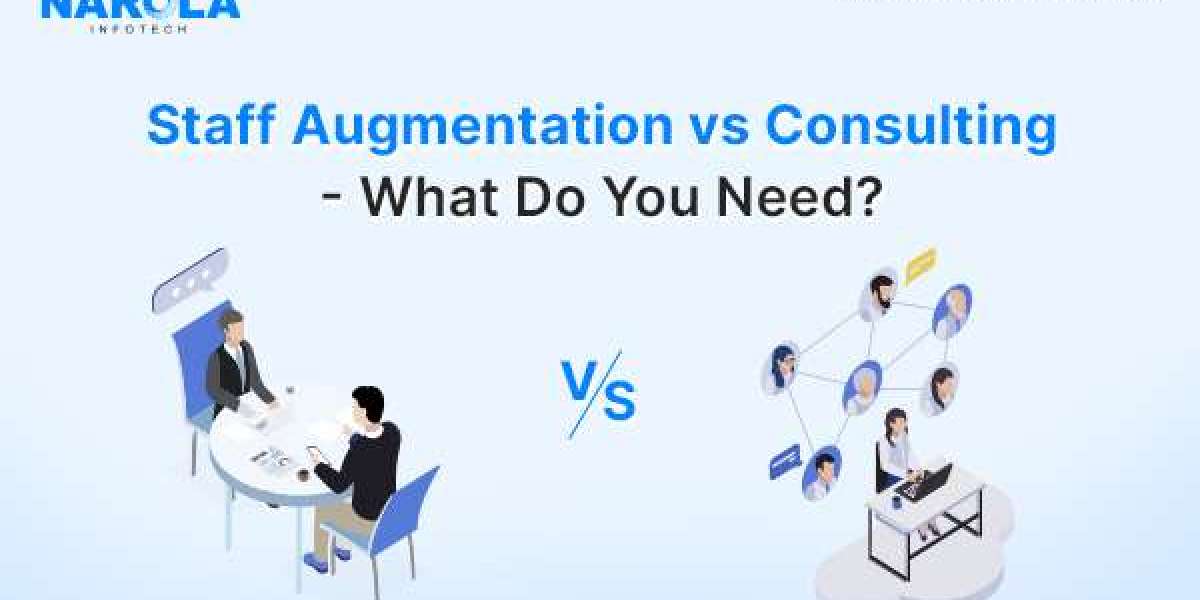Agility is essential to accomplish project objectives and promote steady growth for your company. But when you're working on important projects that call for particular skill sets, you can find yourself in a difficult situation.
Is it better to hire a consulting firm to offer strategic experience, or should you add more members to your current team? Although staff augmentation and consulting are both dependable alternatives, their applicability differs depending on the situation.
This blog explores the subtle differences between staff augmentation and consulting to help you make an informed decision when managing challenging projects and business issues.
What Is Staff Augmentation?
Staff augmentation, frequently referred to as flexible recruiting, enables you to bring on temporary, qualified team members. It isn't concentrated on long-term fixes or strategic advancements like consulting is.
In place of recruiting full-time staff members or contractors, this strategy involves contracting with a third-party team or a developer for specialized jobs like system integration or product development.
The main benefit? It makes workforce expansion quick and simple without requiring full-time hiring's long-term commitment. In addition, depending on the nature of your project, it can save a lot of money and time in comparison to hiring someone inside.
What is Consulting?
Consulting is providing clients with expert advice or services in exchange for a fair price. These experts, or consultants, fill up skill gaps where internal resources are insufficient or offer their distinct experience to the table, which is frequently inaccessible within an organization.
Consultants are outside specialists hired for particular or unique projects; they are usually not paid by the customer. They can work as independent contractors full-time or through different companies while taking on more freelancing employment.
Staff Augmentation vs. Consulting: What's the Difference?
The sections above may have made it clear to you that consulting and staff augmentation for IT are two different ideas. In order to determine which better meets your needs, it's crucial to compare staff augmentation with consulting and vice versa. There are important distinctions between these two that you should be aware of in addition to their fundamental meanings.
1. Engagement
Staff augmentation is the process of expanding an existing team by employing more workers or resources. Under your supervision, the augmented workforce completes duties and makes contributions to ongoing initiatives. They join your internal teams and are frequently incorporated into your workflows and procedures.
Providing knowledgeable counsel, analysis, and direction to address particular business issues is the main goal of consulting. Consultants typically provide the client with strategic recommendations or solutions while working alone or in groups. The specialists here, in contrast to staff augmentation, primarily communicate with stakeholders and decision-makers in order to comprehend the situation, obtain data, and provide recommendations.
2. Purpose
Filling in resource or talent gaps in your organization is one of the main objectives of staff augmentation. More people are needed to finish jobs more quickly and efficiently, or to finish projects sooner.
Conversely, consulting seeks to offer specialized expertise, perspectives, and approaches to deal with particular problems or possibilities. It focuses on offering insightful advice and resolving problems.
3. Operational Involvement
As previously said, the augmented staff members become an essential component of the client's team, collaborating closely with internal staff members, and their engagement is more operational.
Consultants provide an outsider's perspective, but they also retain a certain amount of objectivity. They interact with you to learn about the issue, evaluate it, and make recommendations for fixes—all without really taking on daily management responsibilities.
4. Roles & Responsibilities
The duties you allocate to the augmented staff are in line with their roles and responsibilities. They are responsible for seeing that certain tasks within the project's parameters are completed.
It is the duty of consultants to create plans, offer solutions, and offer strategic counsel. They might not carry out duties directly, but they will advise you on how to put the suggestions into practice.
5. Contract Duration & Flexibility
Staff augmentation typically entails a longer-term contract, with remote developers and other experts joining your team for the project's lifetime or longer if necessary. You have the freedom to adjust the quantity of remote workers to suit your needs in this flexible work environment.
This duration might range from short-term reviews to longer-term strategic planning when specialists are consulted. Usually, clients hire consultants for a set amount of time or until a certain objective is met.
6. Deliverables
The goal of staff augmentation is to allocate jobs or projects to specialists and have them complete them with measurable results.
Contrarily, consulting provides the customer with information, analysis, plans for action, or suggestions to help them solve particular issues or make well-informed decisions.
7. Skills and Expertise
Through staff augmentation, you can obtain specialized knowledge or abilities needed to carry out project-related duties. The need to use these skills right away is emphasized.
However, consulting calls for a wider variety of skills and knowledge. Because of their expertise and experience in deciphering complicated problems and offering strategic insights, consultants are sought for.
8. Risk and Accountability
As augmented staff are members of your internal team, you have more authority and responsibility for the tasks they perform. They provide you with quantifiable outcomes that enable you to assess performance going forward.
A certain amount of accountability is attached to the counsel and suggestions that consultants provide. They might not, however, carry out tasks directly. The quality and efficacy of their instruction is the only basis on which to evaluate their performance.
9. Cost Structure
Typically, staff augmentation entails a simple cost structure, with the additional staff members being paid on an hourly basis or a fixed project compensation. This is frequently adaptable depending on when and how you need developers or other experts.
On the other hand, depending on the nature of the work, the level of skill needed, and the strategic value offered, consulting fees may change. Various pricing methods, such as set fees, retainer-based agreements, or performance-based compensation, may be used in consulting engagements.
10. Impact
The immediate completion of tasks or projects is a common indicator of the impact of staff augmentation. Your operational effectiveness and project delivery schedules are immediately impacted.
However, the performance and competitiveness of your business are ultimately impacted by the strategic decisions, organizational modifications, and process improvements that consulting brings about.
Consulting vs. Staff Augmentation: Which Is Better?
The choice between staff augmentation and consulting is based on a number of criteria unique to your business and needs at the time.
Recall that your business can benefit from using both staff augmentation and consulting as useful tools. You can choose the strategy that best fits your goals and problems at hand by being aware of the advantages and disadvantages of each.
Source: Staff Augmentation vs Consulting








